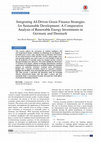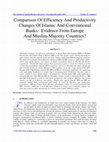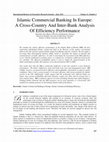Papers by Ahmad ABU-ALKHEIL
Economics and Business Review/The Poznań University of Economics Review, Jun 7, 2024

European journal of business and management research, Mar 29, 2024
This research explores the convergence of synthetic intelligence (SI) and inexperienced finance t... more This research explores the convergence of synthetic intelligence (SI) and inexperienced finance techniques in influencing the development of renewable power sectors, with a specific focus on Denmark and Germany for the critical periods of 2019 and 2020. ANOVA, paired sample t-tests, and regression analysis were used as part of a strict method to look into how the production of renewable energy has changed and how AI-driven financial techniques have affected it. The results spotlight the effectiveness of AI-driven green finance solutions in bringing approximately enormous ameliorations, establishing Denmark as a probable exemplar for sustainable progress. In evaluation, Germany's consistent power infrastructure, blended with a fantastic correlation exposed in regression evaluation, highlights the durability of its environmentally pleasant economic methods. This study presents a well-timed and informative guide for developing effective, inexperienced finance rules that guide a greener and more sustainable future as international locations all around the world address environmental-demanding situations.
Afro-Asian J. of Finance and Accounting

This paper extends prior corporate stock buy back studies by evaluating the effect of stock buyba... more This paper extends prior corporate stock buy back studies by evaluating the effect of stock buybacks on growth and non-growth industries. Regression results indicate that firms categorized in above average growth industries contain a higher degree of information content over firms categorized in below average growth industries, and there appears to be a stronger earnings response among non-buyback firms in the above average growth industries. When assessing the effects of percent change in stock price correlated with long term investment, results indicate that investors perceive earnings associated with non-buyback firms to be informative and good indicators of stock prices and have a strong correlation with long term investment. However, findings indicate that investors perceive earnings associated with buyback firms to be noisy and unclear indicators of stock prices or possessing a strong correlation with long term investment. Introduction Stock buybacks are typically as straightf...

American J of Finance and Accounting, 2013
We employ data envelopment analysis (DEA) to examine the relative efficiency of Islamic and conve... more We employ data envelopment analysis (DEA) to examine the relative efficiency of Islamic and conventional banks in the UK and Switzerland during 2008-2009, accounting ratio analysis to measure the financial performance of the European Islamic Investment Bank (EIIB) during 2005-2008, and a matched-pairs t-test to determine the differences in the EIIB performance in the pre-versus post financial crisis periods, respectively. Results suggest that the Islamic banks in Europe experience lower cost efficiency, higher allocative inefficiency and poor, but relatively better, technical efficiency compared to conventional banks. The inefficiency of the banks is mostly due to their sub-optimal size of operations. Findings further show that the EIIB exhibits a clear paradox between its high operating efficiency and low profitability. EIIB gradually became illiquid but still remains solvent. A comparison of the bank's performance in the periods before and after the crisis does not show statistically significant differences.

American J. of Finance and Accounting, 2018
This paper examines the efficiency performance of 32 Islamic banks (IBs') from Asia, the Midd... more This paper examines the efficiency performance of 32 Islamic banks (IBs') from Asia, the Middle East, Gulf region, and Europe using the stochastic frontier analysis (SFA). Furthermore, the study utilises the ordinary least squares (OLS) approach to analyse the cause–effect relationship between bank-specific factors and banks' efficiency scores over the period from 2004 to 2014. Findings show that the majority of IBs' appear to be inefficient in terms of both generating profits and controlling costs. Banks' substantial inefficiencies are largely technical and partly scale in nature. Results suggest also that IBs' that are more technically efficient are most likely larger in size with low market-share, highly profitable, well-capitalised, supply more lending, and are less leveraged. Overall, the empirical findings reveal that not all IBs' were equally affected during the period of the global financial crisis of 2007. However, tiny observed variations are mainly...

This paper examines the efficiency performance of Bosna Bank International (BBI) in Bosnia-Herzeg... more This paper examines the efficiency performance of Bosna Bank International (BBI) in Bosnia-Herzegovina and Islamic Bank of Britain (IBB) in the UK, against small conventional banks in each country and also against small and large Islamic banks from Muslim-majority countries. This paper also estimates the productivity changes of IBB and BBI relative to small Islamic banks, within and outside Europe, and relative to small conventional banks in the UK and Bosnia respectively. Finally, this paper utilizes OLS regression analysis to check the robustness of the overall data envelopment analysis (DEA) results, as well as to determine the impact of internal and external factors on bank's efficiency. The analysis covers the 4-year period from 2005 through 2008. The findings suggest that IBB and BBI are technically inefficient. In comparison with small banks, inefficiency is largely due to mismanagement. Inefficiency becomes scale in nature relative to large Islamic banks. As compared to Islamic banks, BBI yields higher pure technical efficiency than IBB, but IBB records higher positive growth in estimated efficiency. IBB and BBI yield upward growth in total factor productivity and technical efficiency but record negative growth in technology innovations. Results also suggest that the IBB and BBI lag relatively behind their conventional peer banks in terms of efficiency and productivity performance. BBI shows much better efficiency performance relative to conventional banks than IBB. Overall, a bank that is more efficient is found to be larger, more profitable, acquire less debt, invest more in skills, and operates in countries with a higher GDP per capita.

International Business & Economics Research Journal (IBER), 2012
We examine the relative efficiency performance of the Islamic Bank of Britain (IBB), the first st... more We examine the relative efficiency performance of the Islamic Bank of Britain (IBB), the first stand-alone full-fledged Islamic commercial bank in the Western world, against conventional banks in the UK, and also against Islamic banks from Muslim-majority countries. We also apply a two-stage Data Envelopment Analysis (DEA) model to determine the impact of internal and external factors on bank's efficiency. In order to investigate the association of the DEA-efficiency scores with the traditional accounting ratios, we estimate the correlation coefficients between the two variables. The efficiency-profitability matrix is used to enable the characterization of the banks' performance profile. Our analysis covers the period from 2005 to 2008. Our results show that the IBB is technically inefficient. It also has relatively a poor financial performance. The banks inefficiency stems from both scale (size) and management issues. IBB exhibits, however, an upward trend in efficiency and...
Quarterly Review of Economics and Finance, 2017

Afro-asian J. of Finance and Accounting, 2021
This paper examines the effect of financial leverage (FL) on a bank's performance by adopting... more This paper examines the effect of financial leverage (FL) on a bank's performance by adopting the dynamic generalised method of moments (GMM) estimator over the period 2004-2016. Also, it examines the impact of the recent financial crisis of 2008 on the Jordanian banking industry. The study sample is based on a comprehensive list of listed banks in Amman Stock Exchange (ASE). Findings show that a bank's leverage is a significant determinant of its performance. FL has negative effects on banks' performance. Mainstream and pure Islamic banks were not immune to the crisis. Yet, Islamic banks seem to show positive signs of recovery from the crisis. Converted Islamic banks did not have better immunity to the global shocks than mainstream banks. Large banks had better financial performance than small banks, and new banks are better able to recover from the adverse effects of the crisis than old ones.

Business and Economics Research Journal
Due to current environment awareness, there has been an increase in investment opportunities conc... more Due to current environment awareness, there has been an increase in investment opportunities concerning mutual funds with a focus on environmental issues. This paper analyzes the performance and risk sensitivities of German green mutual funds in comparison with their German socially responsible investment (SRI) and conventional peers. We also evaluate the results of the German green mutual funds in different market conditions. Because of this, we use and compare this performance during three periods, differentiating crises and non-crisis periods. In order to implement this analysis, we apply a CAPM-1 factor and a Carhart 4-factor methodology and find that in the full sample period 2007-2018 period, environmental funds had lower performance than conventional funds and SRI funds with similar characteristics. However, if we focus on crisis and non-crisis periods, the results change. During the financial crisis (2007-2009), green funds achieved adjusted returns slightly better than their peers; in the Eurozone sovereign debt crisis (2010-2012), the results are again similar to the results from the full sample period. And during the non-crisis period, they are not significantly different from conventional mutual funds, but they perform better than SRI mutual funds.
Review of Quantitative Finance and Accounting

Review of Pacific Basin Financial Markets and Policies
In this paper, we compare the performance of Islamic stock indices (ISI) and conventional stock i... more In this paper, we compare the performance of Islamic stock indices (ISI) and conventional stock indices (CSI) from FTSE, DJ, MSCI, S&Ps and Jakarta series using common risk-return metrics. The sample consists of 64 ISI and CSI, and covers the period from 2002 to 2017. The majority of the stock indices are from the Pacific Rim countries’ stock markets. Additionally, we employ the GARCH-M model to examine the impact of past volatility on spot returns. Findings suggest that the ISI are less sensitive to the average market movements compared to the CSI, but surprisingly offer similar raw returns suggesting primary support for the low risk-high return paradox. On further examination, results reveal that M2, Omega, Sharpe and Treynor measures indicate that ISI underperform CSI while Jensen’s alpha and Sortino ratio put ISI ahead of CSI. Moreover, findings show that pre-crisis winners (CSI) were losers during the 2008 crisis but subsequently recovered and ended up with higher returns than ...











Uploads
Papers by Ahmad ABU-ALKHEIL